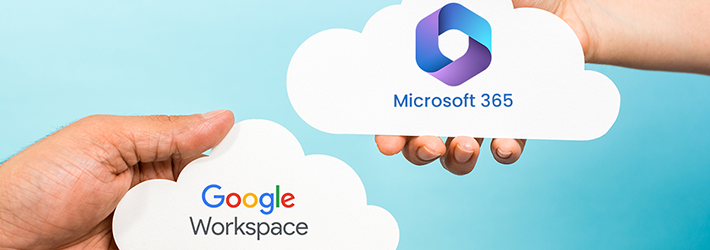Last Updated on December 11, 2024 by Satyendra

With 50% of the market, Google Workspace is generally more widely adopted amongst companies than Microsoft 365, which has a 45% share. Businesses that use Google Workspace include Facebook, YouTube, and Twitter. While Microsoft 365 is also used by big companies, Google Workspace is more well-known.
The practice of locally saving company files has declined in popularity in recent years. Users benefit from greater independence, remote data access, and typically more predictable and cheaper costs with cloud-based apps and managed cloud services. These features can help companies evaluate Google Workspace vs. Microsoft 365, two of the most popular cloud-based productivity suites on the market.
In this blog, we will explore the basics of Google Workspace and Microsoft 355, the pricing and the subscriptions comparison, and Security and Management tools, to help you evaluate which solution is best for your business.
Google Workspace and Microsoft 365
With productivity tool packages like Google Workspace and Microsoft 365, you may accomplish daily work tasks “in the cloud,” through a web browser. These include creating and managing calendars, emails, spreadsheets, presentations, and documentation. Google Workspace was once known as “G Suite,” and Microsoft 365 was formerly known as “Office 365.” Both applications have recently had their names altered.
Microsoft 365 and Google Workspace share numerous similarities. Both are subscription-based and charge monthly fees per user. Google Workspace can function offline even though it is web-based. In addition to desktop apps, Microsoft 365 offers web-based versions of its programs.
Both suites offer many benefits to companies of all sizes and are reliable and strong. Identifying the best productivity suite for your company might be difficult. To give an overview, we have examined the features of Google Workspace and Microsoft 365 below.
Download Whitepaper

Features Comparison
Google Workspace and Microsoft 365 are known to be feature-rich suites combining multiple productivity items into strong, comprehensive solutions. Let’s examine each productivity suite’s features:
| Features | Microsoft 365 | Google Workspace |
|---|---|---|
| Productivity and Collaboration | With Office platform capabilities like co-authoring, change tracking, and live presentations, Microsoft Office 365 promotes a more conventional method of teamwork. | Google Workspace places a strong emphasis on in-app chat, commenting, and direct editing for real-time collaboration. |
| Storage | 1 TB of OneDrive storage and fifty gigabytes of email storage are included in Microsoft 365. | For accounts with five or more users, Google Workspace provides 150GB of drive storage, 30GB of Gmail, and 1 TB of storage per user. |
| Security | Microsoft 365 provides enhanced threat protection features, such as secure attachments and links. Data loss prevention, eDiscovery. | Google Workspace uses cutting-edge AI to automatically identify and block threats like spam and phishing. It also offers two-step verification, security key enforcement, and protection against data loss for Gmail and Drive |
| Third-Party Integration | It is not possible to sync non-Microsoft apps with Microsoft business accounts. Specifically, it can be difficult to access Google Drive from a Microsoft account, which requires linking Google Drive to the OneDrive account. | Google offers a wide variety of third-party apps and services, from accounting software to media players and photo/video editors. This is only one of the numerous reasons why consumers select Google, it gives them access to sophisticated capabilities that they might not receive elsewhere. |
| Data Recovery | Microsoft 365 automatically clears the Recycle Bin when the storage limit is reached and offers a 30-day file history. Litigation Hold and e-discovery are examples of archival techniques that may not be covered by all plans and may not offer straightforward, limitless point-in-time recovery. | Google automatically deletes deleted files after 30 days, giving users access to a 30-day history. File recovery can be laborious, time-consuming, and prone to errors, and Google Vault, despite being archival, is not available with all Google Drive plans. |
Microsoft 365 vs Google Workspace Pricing
Determining whether a cloud service fits your budget and business needs depends heavily on its plans and price. The numerous options offered by Google Workspace and Microsoft 365 will only provide a general notion of which plan is more economical.
Microsoft Plans and Pricing offers both standard and basic business plans, with the basic plan being best suited for companies who need straightforward remote solutions. Each user pays $5 a month for the plan. In contrast, each user can purchase the regular business plan for $12.50 per month. It includes desktop versions of all the premium office products along with the Business Basic plan.
For Google Workspace, this is the perfect option for you if you are beginning a new business or have a small one. This basic plan costs $6 per user per month and gives each user 30GB of cloud storage. Cloud Search, AppSheet, shared drives for your team, and Vault (for storing, archiving, and searching data) are not included in this plan. At $12 per user each month, the most popular Google Workspace plan is the Business Standard plan. Each user of this subscription gets 2TB of cloud storage. With this package, up to 150 people can participate in video meetings, and they can be recorded.
App-Specific Comparison
Every company has different requirements, and yours might value some apps more than others. Word processing and email may be the most crucial office suite applications for certain businesses, while a robust spreadsheet program may be the most essential tool for others.
- Document Editing: Choosing between Google Docs and Microsoft Word for your business is easy. Which do your users value more: basic cooperation or the greatest range of document creation and editing options? Recent updates have made Google Docs nearly as good as Word. Google Docs offers fewer than 60 templates of all types, including personal, business, and educational ones, but Word offers over 200 business templates alone.
- Spreadsheets: Compared to Google Sheets 19, Excel has a much wider range of chart kinds, including more sophisticated ones like radar, surface, and histogram, as well as more well-known ones like box and whisker that are only familiar to data specialists. There are also numerous subtypes of many chart kinds. Google Sheets has seven primary chart kinds and a few unclassifiable individual charts. Additionally, Excel makes chart creation easier than Google Sheets.
- Presentation: Adding multimedia, images, animations, and transitions is made simpler with PowerPoint. It also includes more forms of tables and charts. Furthermore, it provides advanced options for delivering the presentation including cutting-edge features like Rehearse Timings, which allows you to time how long you spend on each slide during presentation practice. However, Google Slides is superior to PowerPoint in terms of functionality. Additionally, because Slides doesn’t have as many features as PowerPoint, it’s a little easier to make slides with it.
- Email: Numerous features in Outlook, such as Quick Steps and customizations, allow for more complex mail-handling automation than Gmail can provide. The contacts and calendar features are also effectively integrated with email because they are a component of Outlook itself. The Google Calendar and Contacts apps, independent of Gmail, can be a little more difficult to use. Gmail has an easy-to-use design with capabilities that make it simple to do tasks quickly. A useful snooze button for postponing incoming messages, an AI-driven function that makes word and phrase suggestions as you type, and a “nudge” feature for bringing up forgotten messages are some of the features. Using its feature that automatically handles messages by filtering to particular folders is also very easy.
- Storage and File Sharing: There is a significant amount of storage in each suite. Regarding storage and shared documents, there isn’t much that separates Microsoft 365 from Google Workspace. Google Drive and Microsoft OneDrive for Business enable file access on any device and interact seamlessly with their respective office suites. Although you can keep the files locally, Workspace stores them in the cloud by default instead of on the devices. With Microsoft 365, they usually reside on both devices and the cloud, and everything syncs simultaneously, however, you can choose to keep some files and folders in the cloud exclusively.
Microsoft 365 vs Google Workspace: Which one should you choose?
Google Workspace and Microsoft 365 offer an extensive list of amazing tools intended to improve productivity and streamline your workflow. The greatest option for startups or small enterprises that need straightforward, user-friendly business apps that can get you up and running right away is Google Workspace.
The preferred productivity package for companies that need strong and advanced functionality is Microsoft 365. Similar collaboration and productivity features are available in Microsoft 365. The learning curve, however, can be somewhat steep in contrast to Google Workspace’s ease of use.
When it comes to “running a business” as opposed to “saving money,” Google Workspace can be a fantastic option for companies that don’t require all of Microsoft 365’s features.
Choosing the appropriate office suite for corporate efficiency could have a significant impact on your organization. The total cost, storage capacity, security and compliance, bundled apps, and ease of use are all important considerations when choosing between Google Workspace and Microsoft 365. In the end, you will need to make a decision based on your organization’s particular needs and priorities.
Securing Your Data With Lepide
Lepide’s Data Security Platform can assist you in protecting your company against security misconfigurations. It also enables you to implement Zero Trust and minimize your attack surface area.
A centralized platform that serves as your primary data security solution is necessary to help a productive and efficient IT team in identifying and minimizing risks without compromising data security. Without requiring complicated on-premises infrastructure, Lepide gives your organization the ability to detect threats and meet compliance across your on-premises and cloud-based infrastructure.
Are you prepared to give it a try? Set up a Demo with one of our experts right now!


 Group Policy Examples and Settings for Effective Administration
Group Policy Examples and Settings for Effective Administration 15 Most Common Types of Cyber Attack and How to Prevent Them
15 Most Common Types of Cyber Attack and How to Prevent Them Why AD Account Keeps Getting Locked Out Frequently and How to Resolve It
Why AD Account Keeps Getting Locked Out Frequently and How to Resolve It
